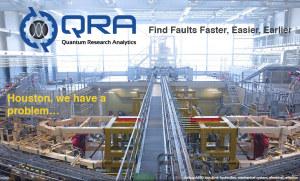As we move closer toward the “internet of things,” where our technology, transportation systems and even appliances start making decisions automatically and without our input, we’ll need to develop testing methodologies to insure the safety of those networked systems for both civilian and military applications.
That’s why we’ll need firms like Halifax-based Quantum Research Analytics (QRA).
“A design error is always easier to fix at the design stage than at the production stage,” says Eduardo Vaz, the company’s director of business development. He’s one of a small team developing testing and fault protection tools for the next generation of embedded cyber-physical systems in manufacturing and transportation.
Most of the team began as part of the Quantum Theory Group at Dalhousie University and only morphed into a business in 2012, Vaz explained. “Our core mandate is focused on developing the most advanced analysis tools, on the most advanced hardware, to help validate the world’s most complex cyber-physical systems.”
The company was created at an opportune time. A surprising number of those “cyber-physical systems” are being built into the current and upcoming generation of civilian and military aircraft.
One of the first “cyber-physical systems” was the General Dynamics F-16 Fighting Falcon, which was intentionally designed to be aerodynamically unstable to increase maneuverability. Of course, since a less stable design will have a faster response to control inputs, but also be more difficult for the pilot to control, the F-16 made use of an automated control system connecting all the aircraft control surfaces which operated without pilot input.
This freed the pilot to worry less about crashing and more about the primary mission. The new system worked so well, it was subsequently adapted for other aircraft as part of a “fly by wire” system.
Current designs utilizing variations of this system include civilian aircraft such as the Airbus A320, the Boeing 777, Boeing 787, Bombardier CSeries and the Dassault Falcon 7X business jet; military fighters and bombers such as the F-18/22, the Dassault Rafale and the F-35 Joint Strike Fighter; and even helicopters such as the V-22 Osprey, the RAH-66 Comanche and the Sikorsky S-92.
And with control surfaces on modern aircraft now connected electronically instead of just mechanically, software testing is suddenly a vital adjunct in the process of supporting traditional test pilots.
“Thirty to 40 percent of modern aerospace design and development work is related to testing,” says Vaz, “and we’ve built a tool-set powerful enough to validate and verify complex, interactive systems at the beginning of their aerospace design cycle, when the cost of revision is lowest.”
But the QRA tools aren’t just for aircraft.
Industry also requires useful tools for the testing and validation of the “industrial internet,” a term coined by General Electric a few years back to describe the integration of complex physical machinery with networked sensors where the collected data is used to automatically adjust and optimize operations.
Even from a ground combat perspective, the concept of a “connected battlefield,” with rugged, embedded computers and sensors tracking and improving the effectiveness of both soldiers and their equipment, but capable of providing real time, actionable updates to commanders, is not a new thing, especially to anyone who watched the 1986 James Cameron movie, Aliens.
Given the processing requirements for testing the enormous amounts of data collected as part of the testing processes, it’s surprising to note that the QRA software does not require the types of quantum computers being developed at places like Burnaby, B.C.-based D-Wave Systems in order to effectively function, although they can be utilized when the architecture offers a performance boost.
According to Vaz, “we currently have access to D-Wave hardware along with hardware from others such as IBM, but we are not limited to any one specific configuration. We are always open to options relating to the optimum testing configurations of both our tools and the test platform.”
In fact, QRA is looking to develop relationships with testing partners, to validate and develop new configurations for the tool-set. So if you’re in manufacturing or aerospace and developing complex systems requiring powerful testing solutions, QRA is eager to talk..
But hurry. Although currently “pre-commercial” and certainly open to ideas, the firm might not stay that way for long.
Nicole Verkindt is the founder and president of OMX, and founded the Southern Ontario Defence Association. She was recently appointed to the Board of the Peter Munk School of Global Affairs.

